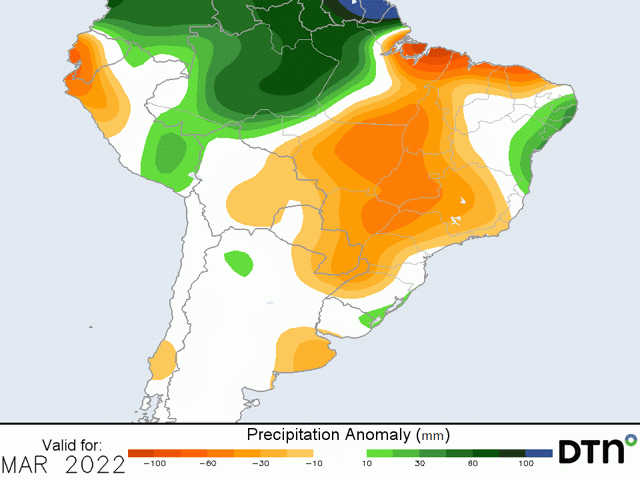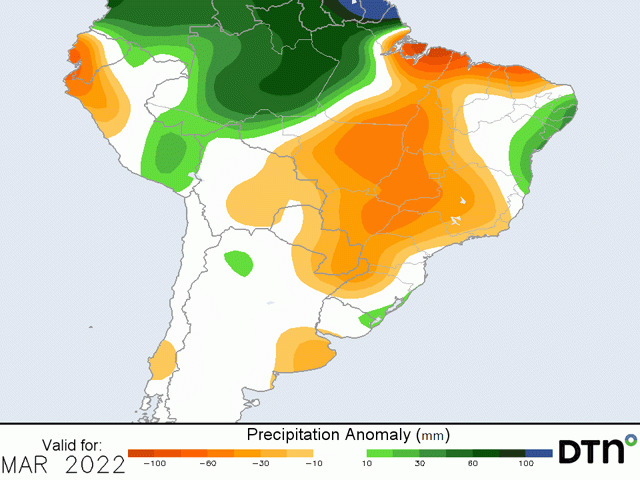South America Calling
March Forecast Difficult for Safrinha Corn in Brazil
Attention in South America has been focused across the southern half of the continent over the last couple of months -- and rightly so. Dryness and drought have built into Argentina and southern Brazil for quite some time thanks to La Nina.
But La Nina is starting to lose its grip on the Pacific Ocean. The conditions still point to La Nina continuing, but it appears to have peaked, and most models are pointing toward getting into a El Nino Southern Oscillation (ENSO) neutral state by Southern Hemisphere winter. Weaknesses are leading to some better rainfall chances for the next seven to ten days across Argentina and southern Brazil, but dryness resumes afterward for most of the month of March. The limited showers will not be able to end the drought.
Farther north throughout much of central and northern Brazil, wetness has been the bigger concern. With the wet season starting on time in late September and early October, soybean planting got off to a ravenous pace. In fact, it was the fastest start in the last five years in the highest production state of Mato Grosso, according to the Mato Grosso Institute of Agricultural Economy (IMEA).
That favored on-time or early harvest and subsequent on-time or early planting of second-season corn (safrinha). But the rains that have come with the wet season have been rather intense over the last several months. Usually there will be several periods where showers will let up and become more isolated for a time while the focus shifts farther south. But with the southern half of the continent staying dry, all the moisture has remained in central and northern Brazil since the wet season started. Only a couple of times have the showers weakened.
P[L1] D[0x0] M[300x250] OOP[F] ADUNIT[] T[]
One of those dry periods occurred in mid- to late-January and the soybean harvest got off to an expected quick start. Wetness has since returned and slowed progress on both the harvest of soybeans and the planting of safrinha corn; but the pace is still ahead of normal.
The preferred planting window for safrinha corn is closing with AgRural estimating 53% of the safrinha corn crop having been planted. At over 68% complete, Mato Grosso leads the way, though the pace of progress has been slowing due to rains. The laggards are in the southern end of the country as producers in the state of Parana have only completed 36% of their plantings. Producers there have been waiting for better moisture conditions and are now running into concerns that their seasons will extend well into June and July, risking chances for frosts.
La Nina increases the chances for frosts across southern Brazil in June and July. In 2021, three rounds of frost devastated crops in the country. Late planting left the crop in reproductive stages of development during the earliest frost so the risk will be there again this season. The DTN forecast does indicate frost to be a risk again this year.
But La Nina also has another impact -- a quicker end to the wet season. Typically, the end of the wet season is very abrupt and averages around the beginning of May. By that time, the hope is that crops have gone through reproductive stages of development and going into grain-fill. That leaves them with plenty of subsoil moisture to carry out the rest of the season in good shape. However, a quicker end to the rains leaves corn at more substantial risk of having to also go through reproduction with subsoil moisture. On average, La Nina shuts down the wet season about two weeks early. Last year, it was more like a full month. With a little over half of the safrinha crop planted, there is some potential for more of the crop to risk going through more of the season in dryness.
Subsoil moisture, then, will be pertinent for maintaining good prospects. So far, soils are well stocked for Mato Grosso, Goias and Minas Gerais, which represents roughly 60% of the total safrinha corn production in Brazil. About 30% of production is in Mato Grosso do Sul, Sao Paulo and Parana -- three states that are in serious drought the farther south you go. Subsoil moisture there just does not exist.
And the month of March does not look to help the situation. Though we are seeing a period of better rainfall over southern Brazil and Argentina into the first full week of March, models are pointing at reduced chances for rainfall for the rest of the month. But the effect may be greater in central and northern Brazil. Mato Grosso averages 160 to 200 millimeters (roughly six to eight inches) of rainfall in the month of March. The DTN forecast may cut that in half in some places. While subsoil moisture is more than adequate to make up the difference, there is some concern that more limited moisture could start to draw moisture out of the subsoils rather than keep them stocked, which would be more of a concern should the wet season end early.
Soybean production has been cut drastically in both Brazil and Argentina over the drought conditions there. Cuts in corn production have been tempered based on the safrinha crop that is still being planted with a long season to go. There will be challenges through. That was obvious for southern Brazil, but concern may be growing farther north as well.
To find more international weather conditions and your local forecast from DTN, head over to https://www.dtnpf.com/…
John Baranick can be reached at john.baranick@dtn.com
(c) Copyright 2022 DTN, LLC. All rights reserved.





Comments
To comment, please Log In or Join our Community .